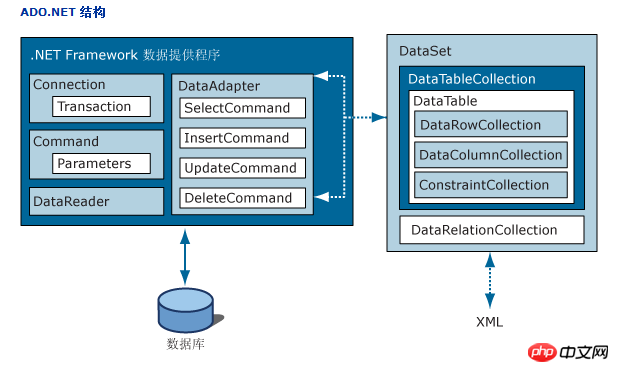
1. Introduction
Ado.net is the data provider of .net framework. It mainly consists of five objects: SqlConnection, SqlCommand, SqlDataAdapter, SqlDataReader and DataSet. The structure is as follows

1.SqlConnection class represents a connection to a sql server database
The connection string format generally has the following two forms, specifically Parameters can refer to msdn
1) Persist Security Info=False;Integrated Security=true;Initial Catalog=Northwind;server=(local)
2) Server=.;Database=demodb;User =sa;Password=123;
Create a connection as follows
SqlConnection conn = new SqlConnection(connString);
2.SqlCommand class represents the database execution command Object
1) Used to set the SQL script or stored procedure, timeout, parameters and transactions that need to be executed.
2) The creation method is as follows
SqlConnection conn = new SqlConnection();
## CreateCommand(); ##
//Method 2
SqlCommand cmd = new
SqlCommand(); cmd.CommandText = "select * from table" ;## cmd.Connection = conn;
3) Several main methods ExecuteNonQuery: Execute sql statements on the connection and return the number of affected rows, mainly performing add, delete and modify operations
ExecuteReader: Execute the query and return the SqlDataReader object
ExecuteScalar: Execute the query and return the first row and column of the result set
3.SqlDataAdapterClass is used to fill DataSet and update database data commands and database connections
This class has 4 constructors as follows
public SqlDataAdapter();
## public SqlDataAdapter(SqlCommand selectCommand);
public SqlDataAdapter(string selectCommandText, SqlConnection selectConnection);
##public SqlDataAdapter(string selectCommandText, string selectConnectionString);
4.SqlDataReaderclass provides a data stream-only way to read
5.DataSetclass represents the cache of data in memory
2. Simple implementation of ADO.NETThe following implements an add, delete, modify, Check the example
public class EasySqlHelper
{
//web.config来配置
//private static string connString = ConfigurationManager.AppSettings["SqlConnectionString"];
private static string connString = "Server=.;Database=demodb;User=sa;Password=123;";
public static int ExecuteNonQuery(string sql)
{
using (SqlConnection conn = new SqlConnection(connString))
{
using (SqlCommand cmd = new SqlCommand(sql, conn))
{
if (conn.State != ConnectionState.Open)
{
conn.Open();
}
return cmd.ExecuteNonQuery();
}
}
}
public static SqlDataReader ExecuteReader(string sql)
{
SqlConnection conn = new SqlConnection(connString);
SqlCommand cmd = new SqlCommand(sql, conn);
SqlDataReader rdr = null;
try
{
if (conn.State != ConnectionState.Open)
{
conn.Open();
}
rdr = cmd.ExecuteReader();
}
catch (SqlException ex)
{
conn.Dispose();
cmd.Dispose();
if (rdr != null)
{
rdr.Dispose();
}
throw ex;
}
finally
{
cmd.Dispose();
}
return rdr;
}
public static DataTable ExecuteDataTable(string sql)
{
using (SqlConnection conn = new SqlConnection(connString))
{
using (SqlCommand cmd = new SqlCommand(sql, conn))
{
if (conn.State != ConnectionState.Open)
{
conn.Open();
}
SqlDataAdapter adp = new SqlDataAdapter(cmd);
DataSet ds = new DataSet();
adp.Fill(ds);
return ds.Tables[0];
}
}
}
}The above code is only valid for sql server. If you want to implement different databases such as Oracle, you need to write another one. Set of codes, .Net provides the DbProviderFactory class to create different database instances.
At the same time, the above five major objects should also be replaced with DbConnection, DbCommand, DbDataReader, and DbDataAdapter to abstract the specific sql server objects into more specific objects that have nothing to do with the database type.
//// <summary>
/// 连接信息
/// </summary>
public class ConnectionInfo
{
private string _connectionString;
private string _providerName;
/// <summary>
/// 连接字符串
/// </summary>
public string ConnectionString
{
get { return _connectionString; }
}
/// <summary>
/// 提供程序的固定名称
/// </summary>
public string ProviderName
{
get { return _providerName; }
}
public ConnectionInfo(string connectionString, string providerName)
{
_connectionString = connectionString;
_providerName = providerName;
}
}
public class MySqlHelper
{
private static DbProviderFactory dbProvider;
private static readonly ConnectionInfo connInfo = new ConnectionInfo("Server=.;Database=demodb;User=sa;Password=123;", "System.Data.SqlClient");
private static void GetProvider()
{
dbProvider = DbProviderFactories.GetFactory(connInfo.ProviderName);
}
static MySqlHelper()
{
GetProvider();
}
public static int ExecuteNonQuery(string sql, DbParameter[] parameters)
{
int flag = 0;
using (DbConnection conn = dbProvider.CreateConnection())
{
conn.ConnectionString = connInfo.ConnectionString;
conn.Open();
using (DbCommand cmd = conn.CreateCommand())
{
cmd.CommandText = sql;
if (parameters != null && parameters.Length > 0)
{
cmd.Parameters.AddRange(parameters);
}
flag = cmd.ExecuteNonQuery();
}
}
return flag;
}
public static void ExecuteReader(string sql, DbParameter[] parameters, Action<IDataReader> action)
{
IDataReader rdr = null;
using (DbConnection conn = dbProvider.CreateConnection())
{
conn.ConnectionString = connInfo.ConnectionString;
conn.Open();
using (DbCommand cmd = conn.CreateCommand())
{
cmd.CommandText = sql;
if (parameters != null && parameters.Length > 0)
{
cmd.Parameters.AddRange(parameters);
}
rdr = cmd.ExecuteReader();
action(rdr);
rdr.Close();
}
}
}
public static DataTable ExecuteDataTable(string sql, DbParameter[] parameters)
{
DataTable dt = null;
using (DbConnection conn = dbProvider.CreateConnection())
{
conn.ConnectionString = connInfo.ConnectionString;
conn.Open();
using (DbCommand cmd = conn.CreateCommand())
{
cmd.CommandText = sql;
if (parameters != null && parameters.Length > 0)
{
cmd.Parameters.AddRange(parameters);
}
IDataReader rdr = cmd.ExecuteReader();
dt = new DataTable();
dt.Load(rdr);
rdr.Close();
}
return dt;
}
}
}There are Dapper, IBatis.Net, etc., you can refer to them for reference
【Related Recommendations】
1.
ASP.NET Free Video TutorialC#Use Ado.Net to update and add data to Excel tables MethodADO.NET reads the EXCEL implementation code ((c#))ADO.NET calls the stored procedure ado.net connection vs database codeThe above is the detailed content of What is ado.net and its simple implementation details. For more information, please follow other related articles on the PHP Chinese website!
 How to buy and sell Bitcoin on okex
How to buy and sell Bitcoin on okex
 How to implement linked list in go
How to implement linked list in go
 How to recover files emptied from Recycle Bin
How to recover files emptied from Recycle Bin
 Interview assessment tools
Interview assessment tools
 The difference between win10 home version and professional version
The difference between win10 home version and professional version
 Introduction to the three core components of hadoop
Introduction to the three core components of hadoop
 The difference between win10 sleep and hibernation
The difference between win10 sleep and hibernation
 Telecom cdma
Telecom cdma




